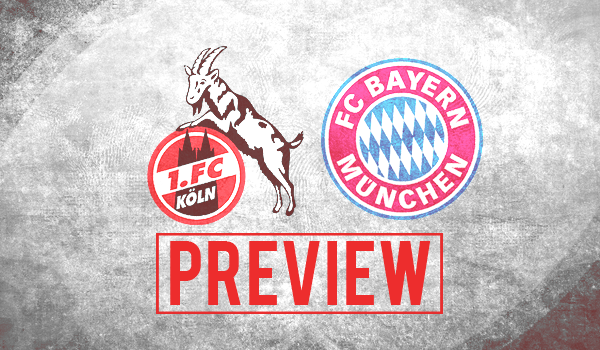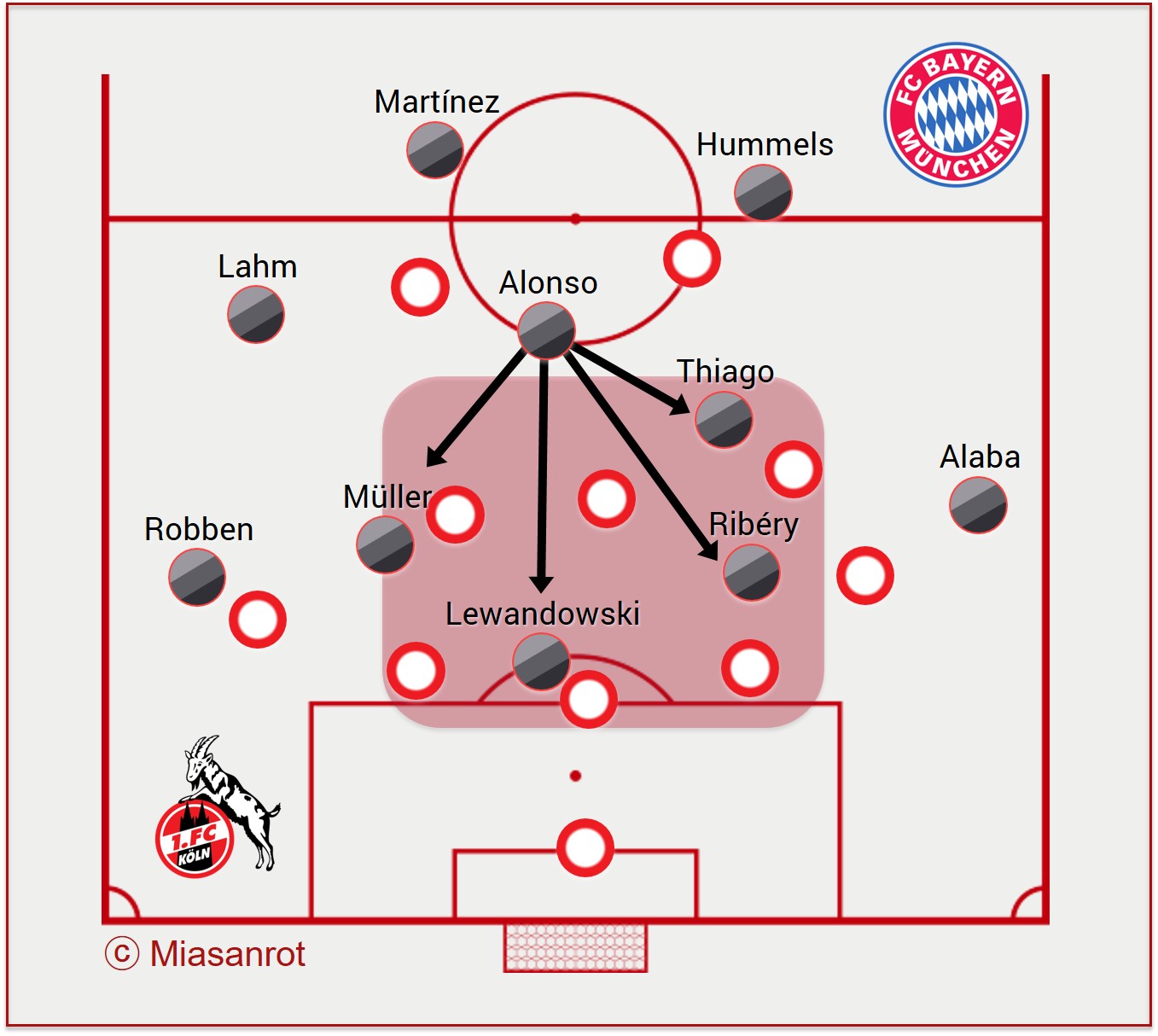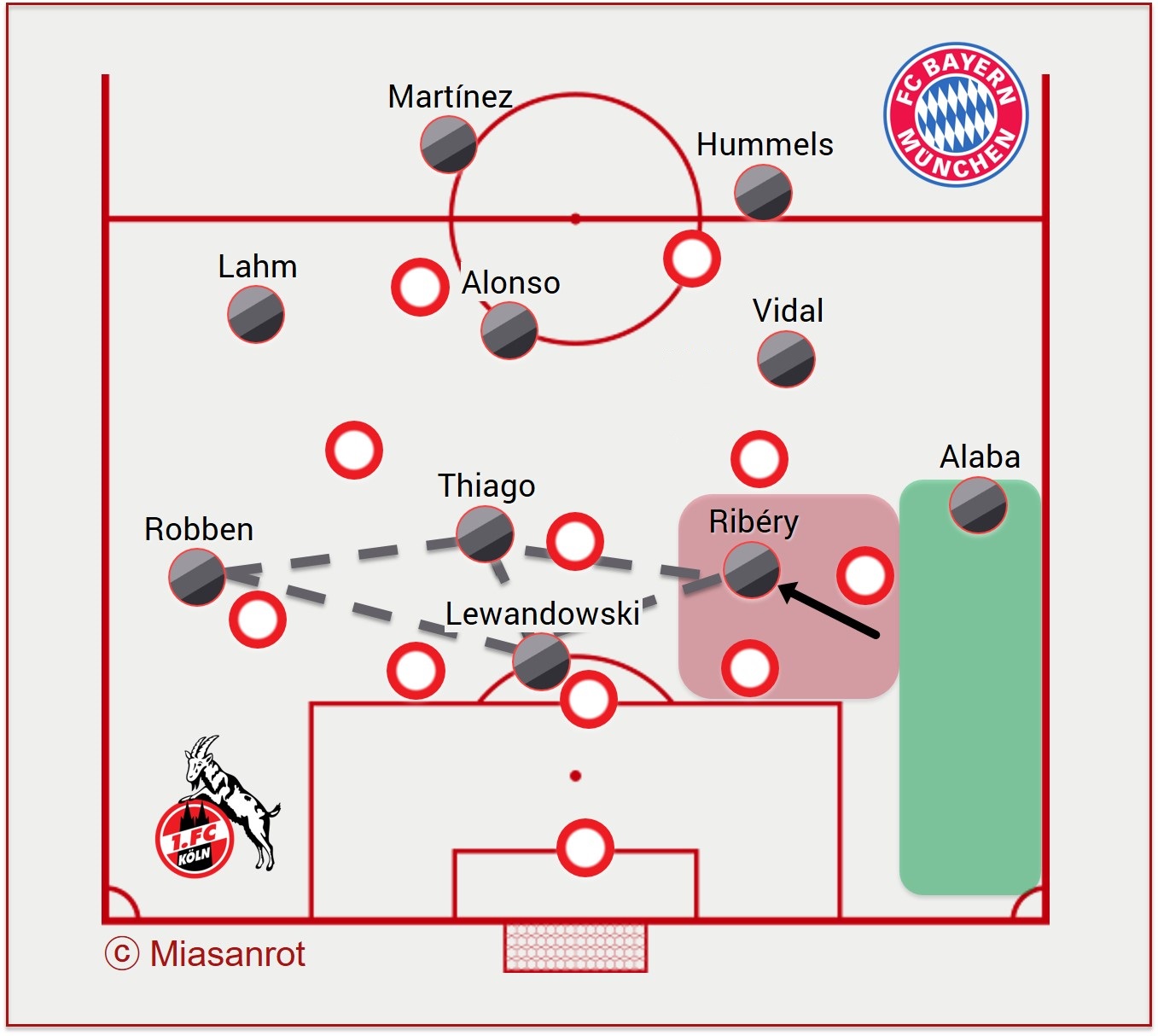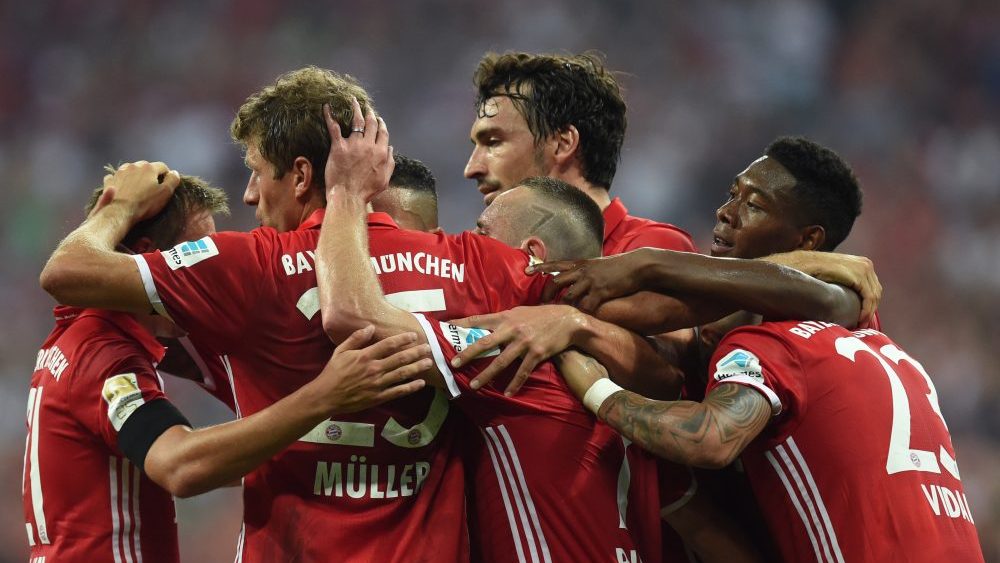Preview: 1. FC Cologne – FC Bayern
Yes, Munich are currently the best away team in the league. However, after Cologne, they still have to visit Gladbach, Hoffenheim, Leverkusen, Wolfsburg and Leipzig. Stadiums where the record champion has dropped points in the past. Recently, many away games have been very tight games, too.
Carlo Ancelotti’s team should be well-prepared for the upcoming weeks. Although Bayern found their form at the right time, a it’s important to put it into context.
With Arsenal, Hamburg and Schalke, three teams played into the hands of the German champion at the Allianz Arena. They left key players too much space, couldn’t find a solution to play through Bayern’s pressing, or were in bad shape to some extent.
Nevertheless, important tweaks have been made. Barely adjusting the personnel made Munich’s work against the ball much more effective. For Ancelotti, two options have become evident.

Alteration of the lineup of death
Steffen coined the phrase “lineup of death“, a term borrowed from basketball, and it has nearly made its comeback under Ancelotti. While Guardiola fielded five attackers and Thiago, it’s now four attackers as well as the Spanish midfielder.
Against Mainz, Wolfsburg and Hamburg, the manager has been pretty successful with it. 52 shots on goal, 16 goals and only one goal conceded. The formation doesn’t only have incredible penetration, it also helps the counter-pressing.
With plenty of players in the final third, Bayern could exercise huge pressure on their opponents. Moreover, lots of triangles are created almost automatically with this much individual class. The distances when losing possession are therefore shorter.

With Ribéry moving inside and Alaba pushing forward, Bayern have up to six players in the attacking third at times. The former problem with the playmaker space is solved by four players at once and Lewandowski massively benefits from it.
The Polish international has scored seven times in the last three matches. Especially against a back-five with three centre-backs, he needs support around him. One playmaker usually isn’t enough.
Speaking of support, Thomas Müller’s name has been mentioned time and time again in the last years. The German was at his best in this formation, too. Despite his patchy season, in the three appearances he’s chipped in with one goal and three assists.
So far, Alonso has only played 19 minutes in the lineup of death 2.0. It could also appeal to the Spaniard, however. In possession, he’d be delighted with a lot of passing options; it would be especially beneficial for his vertical game, which has been so important lately. Having said that, once Munich’s counter-pressing got outplayed, the World Cup winner would be fairly isolated in midfield. He’s not suited to these situations and technically adept teams are able to exploit this.

The option without Müller
Unlike Alonso, Thomas Müller has been rather less involved this season. His problems have been going on from the get-go. Bayern’s luxury squad is Ancelotti’s doom. In the first lineup option, shown above, Müller flourished, however it’s very fragile as soon as possession is lost. This makes it unsuitable for games against several opponents. In those cases, Müller is usually the first one out of the team.
Thiago is just too important, Vidal and Alonso have also found some form, and Müller simply struggled a bit too often. Sporting wise, it’s definitely an understandable decision to choose a more compact setup in midfield.
Müller works best with Thiago and Lewandowski. Ancelotti can’t, and won’t, sacrifice a winger for this. At the beginning of his tenure this already didn’t work.

The advantage of the 4-2-3-1 with Thiago as a playmaker as well as Vidal and Alonso behind him is that two players that are positioned deeper can prevent most counter attacks with their anticipation.
Furthermore, Thiago is very important for the record champion in higher zones because he can get promising interceptions there. The counter-pressing isn’t as effective as in the aforementioned variant when Vidal sits deep. In return, the formation is more compact as a whole.
It seems that Ancelotti has chosen the first option for the all-or-nothing games. This was the case against Leipzig, Arsenal, and Schalke, at least. With success and a lot of goals each time.
Overall, the penetration with Müller as an additional forward is probably still higher. Even if the 60 shots on target in the more compact setup tell a supposedly different story. Ultimately a lot also depends on how the players interpret their position.
With Müller and Thiago, possession seems more homogenous in the final third, compared to Vidal and Thiago. However, the latter two create such power and force in counter-pressing that not many teams in the world can withstand it. The higher Vidal is operating, the better for Bayern’s counter-pressing. Therefore, Müller’s incorporation will continue to be an issue.
Equally problematic could be the combination of Alonso and Vidal in defensive midfield. Both haven’t always chimed well together. Alonso is much more effective and creative with a technically adept partner, while Vidal doesn’t help him often enough.
Lahm and Vidal, Thiago and Alonso, as well as Thiago and Vidal work better so far. Most interesting would be the duo Kimmich and Thiago, which is yet to happen. On paper, both complement each other perfectly.
Ancelotti has now settled on the physically strongest duo. It’s less effective for the playing style, but the Italian can count on their experience. This far, success has always proven him right. And when Vidal is further up the field, he and Thiago might just form the best pressing duo in the world. Ancelotti will adjust to the opponent and field the best variant for that moment.
Ribéry benefits from Ancelotti
While Müller might be one of the losers of this season, Ribéry is a winner. Unter Ancelotti, the Frenchman has hit really good form again. Partly because he gets along much better with his role than Douglas Costa.

It’s defined by moving inside. As a result, he doesn’t only open important spaces for Alaba, he also gets into zones where his decreased speed isn’t noticeable.
On top of that the 33-year old is more intelligent on the pitch, albeit acting too hastily at times. Loss of possession that is often caused directly by his failed dribblings is problematic at most. Ribéry is still an overly important piece to Bayern, even if he can’t always deliver for the whole 90 minutes.
Costa could do that too, but he’s struggling with having to move inside. His passing is not spectacular enough for playing closer towards the centre. Furthermore, his understanding of tight spaces isn’t outstanding, although he has already improved in that area.
The Brazilian is great on the touchline and has been integrated best when the full-backs made diagonal runs to create spaces for him. This rarely happens under Ancelotti – and when it does it’s by Bernat, who’s hardly getting any games.
Losers of the new setup
Recently, we’ve demanded rhythm. Looks like Ancelotti is willing to encourage it now – even if it comes at the expense of some players. Next to Thomas Müller and Douglas Costa, whose problems have already been explained in this text, especially young players have to be added to that list.
Joshua Kimmich has played 1,444 of 3,060 possible minutes. This is still 13th place in the squad, although it might be insufficient for a player of his class. The German international is slowly drifting away from being classed as a talent.
Even Rafinha is more likely to get a rotation spot in the right-back position than the 22-year old. Juan Bernat (1,011 minutes), Renato Sanches (674 minutes) and Kingsley Coman (517 minutes) are sharing his fate. Although the latter has missed a lot of games due to injury. It’s not currently foreseeable if the situation for these young players will improve any time soon. Ancelotti is banking on the two formations where youth doesn’t have a place.
On the other hand, this is only consequent. Kimmich might deserve more game time, but the manager has settled on two variants that work without him. In the big games there’s only going to be change if someone gets injured. This means that Kimmich has to be patient. His time will come soon, the former Stuttgart player should know that himself.
With Ancelotti’s appointment, the club has chosen a defined goal over development. To reach that goal, the 57-year-old has to convince the youngsters to accept their role for this season. Everything else is a question for next season.

(Photo: Johannes Simon / Bongarts / Getty Images)
Cologne as a starting signal
It will be highly interesting to see which team Ancelotti is going to field against Cologne. Does he think Cologne are a chance to rotate the squad, or does he still consider the Bundesliga title race as tight enough to barely make any changes?
Five points’ advantage would legitimise a bit of rotation, but with the remaining away schedule, the three points should really go back to Munich.
Ancelotti’s most important task is to find a healthy balance between rhythm and rotation. So far he’s had some problems with it, although the overall poor performance by everyone in the Bundesliga has played into his hands. However, now he’s found his two formations, which should lead to titles in the end.
If he’s able to shape the pressing to make it more consistent in the second line, FC Bayern is a serious contender for every competition. Even the Champions League. Ancelotti is starting to live up to his reputation but now has to affirm it.
In Cologne, it’s not going to be about maintaining the advantage over Leipzig, but rather delivering a performance against an opposition that is going to be set up better tactically than Arsenal, Hamburg, or Schalke. If Munich can pull it off, one can cautiously start dreaming.

Five bold predictions
- Lewandowski scores.
- Kimmich starts.
- Ancelotti fields only three attackers
- Bayern score two goals at most.
- Cologne also score.
Three correct predictions from the Schalke preview result in an overall of 82/150.









